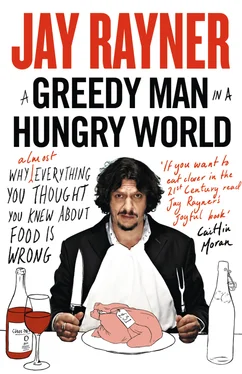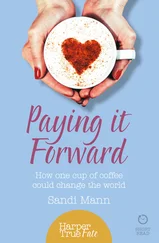And it is where the most dire poverty is concerned that the supermarkets score the most badly. A few years ago I sat down with Heston Blumenthal of the Fat Duck to taste-test products from the supermarket value ranges, the very cheapest of the cheap, the lowest of the low. It was a truly humbling experience. As we studied the prices, all of them measured in pence rather than pounds, we swiftly concluded that whatever aesthetic considerations we might want to bring to bear – Did this stuff taste nice? Was it well made? – were irrelevant. Nobody bought these products because they liked them: they bought them because economic circumstance forced them to do so. And as the banking crisis of 2007 turned into a deep, lengthy recession, more and more people found themselves having to do the same. The big supermarkets were quickly reporting that, while the sales of their premium ranges were dropping, sales of their own-brand budget ranges were rising by over 40 per cent.
So what do you get for your money? Not an awful lot. For a TV investigation I did a forensic job on the cheapest supermarket products. What would you say to a beef pie that was only 18 per cent beef, and a few more per cent ‘beef connective tissue’ – or gristle, collagen and fat, as it’s more commonly known? How about a pork sausage that’s just 40 per cent pork, with a slab of pig skin chucked in for bulk? Or an apple pie with so little apple – a mere 14 per cent – that you can’t help but wonder whether it really deserves the name? I suspect, like me, you would say ‘No thanks’ and pull a ‘What do you take me for?’ face. Then again, I have a choice. I don’t have to buy cheese slices with half the levels of calcium of the more expensive variety or chicken breasts that have been bulked up with 40 per cent water to give you the impression you are getting more for less. The people who are buying these products generally don’t have that choice. They have to take what the supermarkets deign to give them. Which raises the question: is what the supermarkets give them good enough?
Only the most callous could argue that it is. Across the world the big supermarkets have been given all but unfettered access to the massive food retail market. But with that unfettered access must come responsibilities – and surely that should include improving the quality of the food sold to the very poorest in society? We can fight long and hard about what the word ‘quality’ means. The supermarkets will argue that their budget ranges aren’t in any way harmful and point out – rightly – that in recent years great efforts have been made to reduce the levels of salt and sugar in very cheap bread. The age of rickets is over. But that still leaves them selling products that contain animal products that the vast majority of us would actually throw away rather than cook with. Pig skin is apparently quite high in protein, but would you really choose to have it minced up and put in your sausages simply because it’s cheap?
As part of the TV show I worked on, I asked food technologist David Harrison to re-engineer some standard value-range products. I didn’t want him to make a gourmet beef pie. That would be easy. Just throw money and some quality sirloin at the problem. I wanted Harrison to make a better pie, keeping within reasonable financial parameters. He started by analysing all the cheapest pies on the market and found that, on average, they had just 18 per cent beef plus a few more percentage points of that connective tissue. (It can go much lower: I came across a minced beef and onion pie that declared a beef content on the label of just 7 per cent.) Harrison upgraded our generic recipe to produce one that had no connective tissue and 25 per cent beef. The extra cost, to increase the meat content by 38 per cent? A penny a pie. To remove the pig skin from a budget pork sausage and lift the meat content from 40 per cent to 54 per cent cost 0.7p per sausage. To increase the amount of apple in an apple pie by more than 40 per cent cost 0.8p. As the cost of raw ingredients is only a quarter of the finished product’s retail price, these really are tiny amounts. All of these improvements, even represented as double-digit percentages, may look marginal, but the differences in the finished product were discernible. We did a series of blind taste tests and the overwhelming majority of people identified our new improved products and preferred them. And if that sounds like banal advertising patter, so be it.
Obviously companies need to make money, or they wouldn’t be able to invest in their business, which in turn means they wouldn’t be able to serve their customers. But if absorbing the expense to make these improvements meant Tesco’s 2011 half-yearly profits went from £1.95 billion to, say, £1.85 billion, and if Sainsbury’s made not £395 million but £390 million, who exactly would weep? Not me.
Let’s be clear. A 25 per cent meat pie is still not a fabulous item. Nor would Blumenthal and I have swooned over a 54 per cent pork sausage. Likewise, we can lecture those in dire straits on the need to eat more fresh fruit and vegetables – where the value ranges happen to score well – though patronizing people who are struggling to make ends meet has always left me with a nasty taste in the mouth. The fact is that the items I looked at are invariably going to be a part of the diet, and that leads to simple questions of respect; of the supermarkets, which do so well out of us in good times, not forcing the very poorest to eat dross when the bad times come.
Because that’s what we have been living through recently. A survey in late 2012 by the market research company Kantar Worldpanel found that the households on the lowest incomes in Britain were spending more and more money on the very cheapest processed foods, because they were perceived to be more filling. They were buying exactly the grim products that we had trawled through, shoving the country into what was being described as a ‘nutritional recession’. It was presented as a trend, a function of short-term food price rises and falling incomes.
But what happens to the total crap pedalled by the supermarkets to the people with the least choice when, as a result of their own brutal buying policies, the supply chain breaks down? When the prices for absolutely everything go through the roof? When producers from abroad no longer wish to supply the supermarkets and there isn’t enough agricultural production left at home to pick up the slack?
What happens then?
One evening late in 2011 I found myself at a private dinner, sitting next to a very senior board-level executive from one of the big supermarkets. Although I had written positive pieces about the supermarkets in the past, and had explained patiently why they weren’t necessarily evil, my relationships with the big multiples had become increasingly strained. I rarely got an answer from them when, as a journalist, I asked questions. And yet, here I was, sitting next to one of the big beasts. It was an opportunity.
And so, very intently, while filling up the exec’s wine glass, I began to explain my over-arching theory of everything: that by giving the big supermarkets unfettered access to the retail food market we had allowed them to completely destroy farming; that we were becoming increasingly less self-sufficient in food because so many farmers were quitting in the face of horrible business practices. All of this mattered, I said, because of the global food security situation. Some of the price spikes of 2008 might have eased, but it was only a moment’s respite. Those issues would come back to haunt us. Countries like China, India and Brazil would be competing for the resources we wanted and when prices spiked again we would no longer be able to afford them. And when we turned back to Britain for our food needs the supply simply wouldn’t be there. In short, I said, supermarkets had to start paying producers more so they could invest in agriculture and reinforce our food supply system.
Читать дальше












